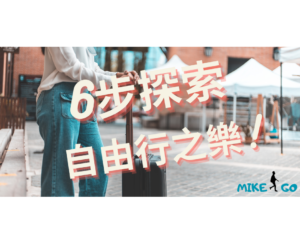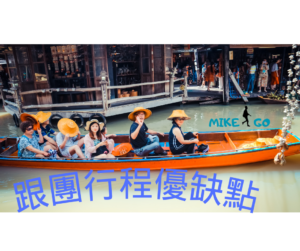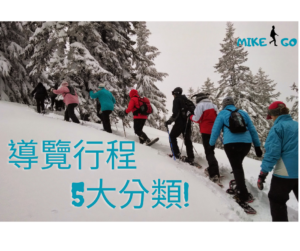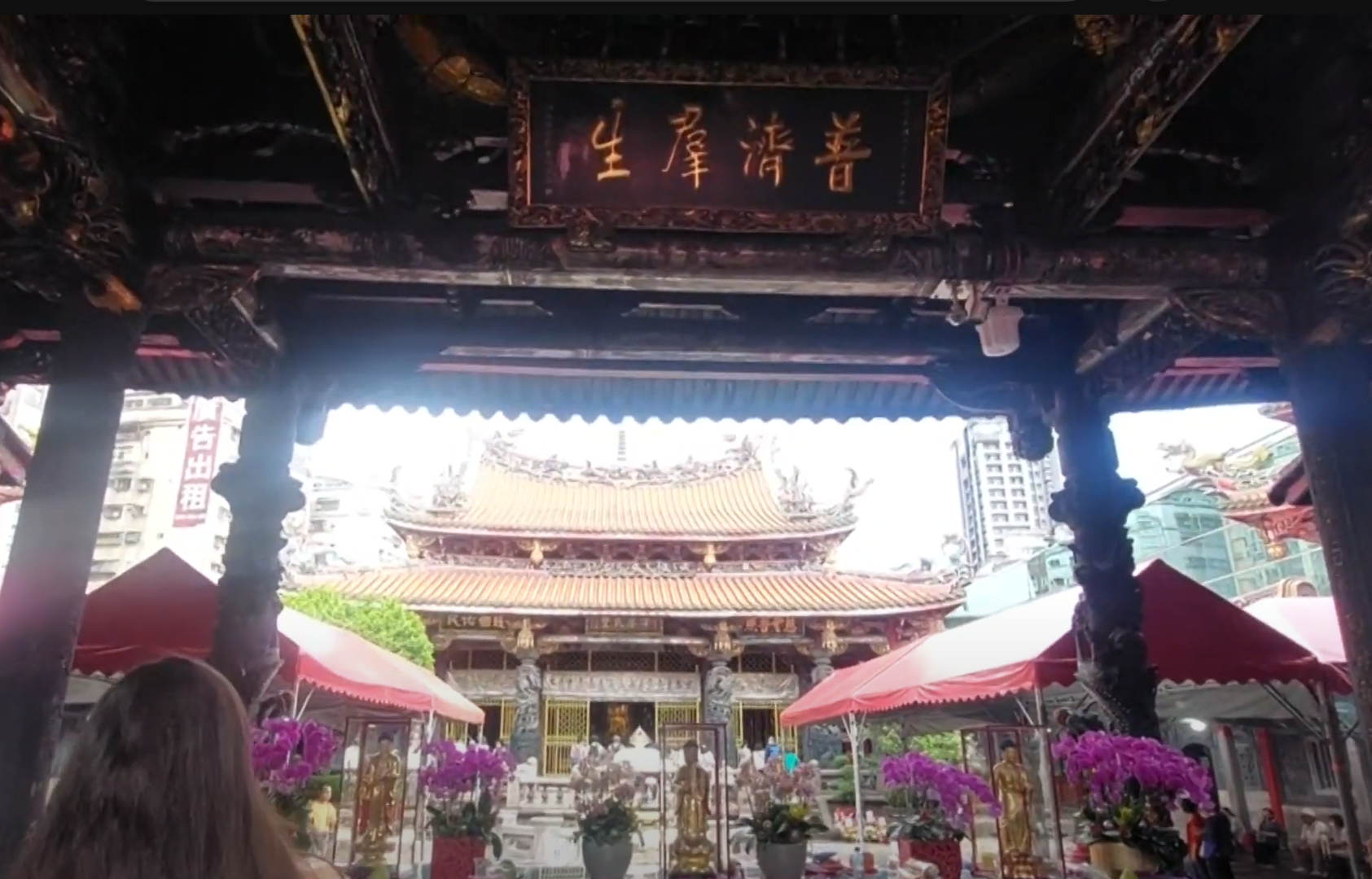

The key points for an English tour of Taipei’s Longshan Temple 台北龍山寺英文導覽6重點
Taipei’s Longshan Temple is the most popular temple in northern Taiwan, attracting visitors from all over the world every day. So, if you have foreign friends visiting Taiwan, be sure to take them there for a visit.
台北龍山寺是台灣北部最受歡迎的寺廟,每天都有來自世界各地的人來參訪。所以有外國朋友來台灣玩,一定要帶他們來走走。
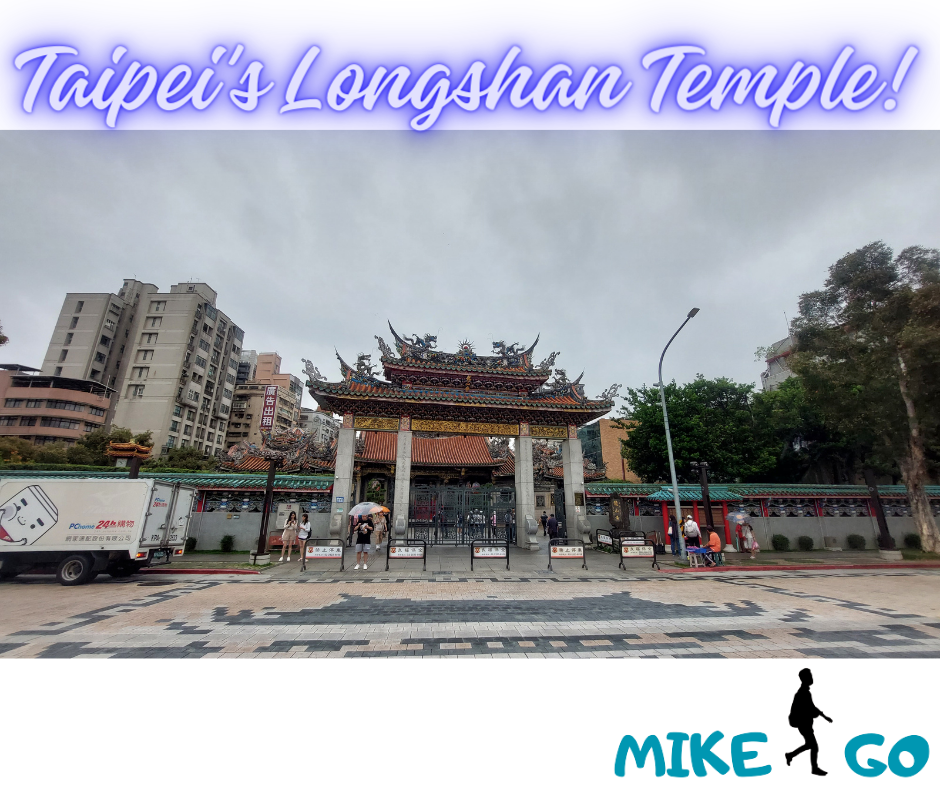

Temples are an integral part of everyday life in Taiwan, deeply intertwined with our culture. Therefore, when foreign visitors come to Taiwan, arranging a visit to temples is a worthwhile itinerary, as it provides insights into how important temple beliefs and culture are to us locals.
廟宇是台灣日常生活中的一部分,與我們息息相關,所以外國人來台灣玩,到廟宇參觀是一個很值得安排的行程,可以了解到廟宇信仰的文化對我們在地人是多麼的重要。
So, how can we introduce it to our foreign friends? Today, I’d like to share a summary of my own key points for the introduction, hoping it can be helpful to everyone.
那到底如何介紹給我們的外國朋友呢? 今天我來分享我自己的介紹重點整理,希望對大家有所幫助喔。
Sights along the way during the car ride. 在車上沿路上景點
◎National Guest House 台北賓館
Originally built as the Governor-General’s Residence during Taiwan’s period of Japanese rule, it now serves as the Republic of China’s National Guest House, dedicated to hosting foreign dignitaries and organizing celebratory events.
最初為臺灣日治時期的總督官邸,現為中華民國的國家迎賓館,專門接待國賓或舉辦慶祝活動。
◎Presidential Office. 總統府
Originally established during the period of Japanese rule in Taiwan as the “Taiwan Governor-General’s Office,” it now serves as the office and workplace for the President, Vice President, and the Office of the President of the Republic of China.
總統府起初於臺灣日治時期做為「臺灣總督府」,為中華民國總統、副總統及總統府的辦公場所。
Klook.comIntroduction to Wanhua District 萬華區介紹
“Wanhua District” is an administrative district name, and “Mengjia” is the former name of Wanhua. During the Japanese colonial era, Mengjia was renamed “Wanhua” due to its pronunciation in Taiwanese (Báng-kah). Today, Taiwanese people still refer to it as “Mengjia.”
「萬華區」是個行政區名,艋舺是萬華舊稱,日治時,因艋舺以台灣話發音(Báng-kah),「艋舺」因此易名為「萬華」,今日台灣人猶稱其為「艋舺」。
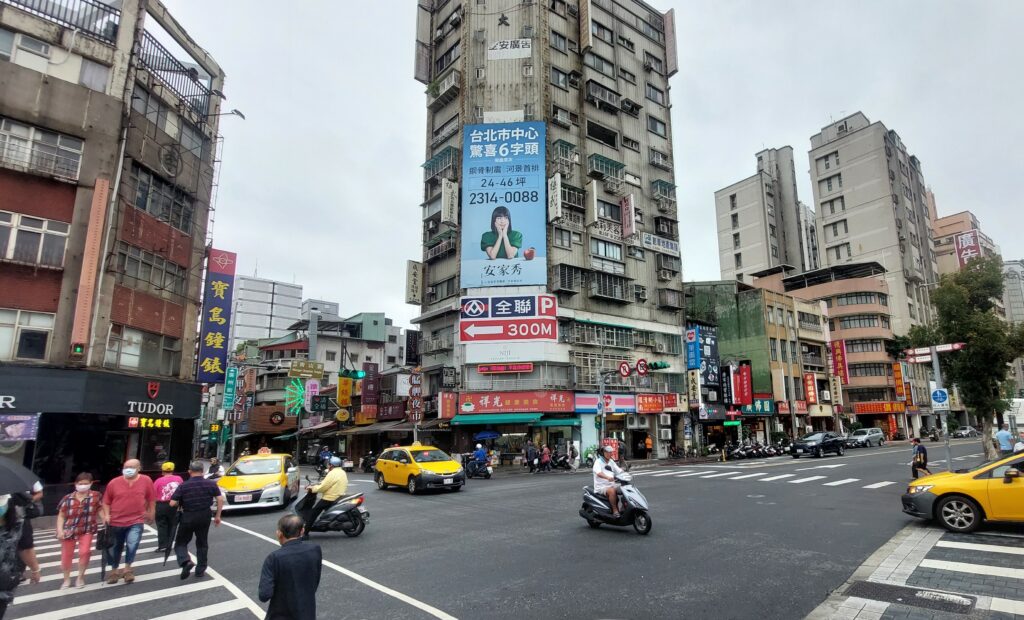

“Mengjia” originally comes from the Taiwanese Plains Indigenous Ketagalan language, meaning “canoe,” as it was a harbor area where canoes were commonly seen. During the Qing Dynasty, it was one of the three important cities alongside Tainan City and Lukang in Changhua County, known as the “One Capital, Two lukang, and Three Mengjias.”
艋舺原為台灣原住民平埔族凱達格蘭族語「獨木舟」之意,因其為港口,多見獨木舟。清治時期,與台南府城、彰化鹿港並列為三大重要城市,有「一府二鹿三艋舺」之稱。
Wanhua District is one of the earliest developed areas in Taipei. However, due to the shift in the city’s central axis, the district has faced challenges such as an aging population and the deterioration of its communities.
萬華區是台北最早發展的區域,後來因為台北市軸心的轉移,萬華區內人口面臨高齡化、社區老舊化的危機。
Introduction to Temple Culture. 廟宇文化介紹
Temples are architectural structures used for worshiping deities, mythological or legendary figures, and revered saints. Temples encompass places of worship for Taoism, known as Taoist temples, Buddhist places of worship called Buddhist temples, as well as ancestral temples or clan temples dedicated to ancestral spirits or deities in accordance with Taoist traditions.
廟宇。是作爲用來供奉神靈、神話或者著名傳説人物、聖賢的房屋式祭祀建築物。而廟宇,還包括信仰道教的宮廟,信奉佛教的佛寺廟,以及尊天法祖祭祀的祖廟或宗廟等等。
Temples have become an integral part of daily life for the people of Taiwan. According to statistics, there are now over 12,000 temples of various sizes throughout the entire island.
廟宇已經融入了台灣人的日常生活當中,據統計,如今全臺已經有超過1.2萬閒大大小小的廟宇。
The main functions of temples are twofold. The first is to seek blessings and ward off misfortune. You can see that people come to temples to pray and seek guidance, wishing for peace and good fortune. The second is to nurture the hearts and minds of individuals by means of education, guidance, and influence, thereby altering their thoughts, behaviors, and beliefs to align more closely with societal ethics, values, and behavioral norms.
廟宇的功能主要有2個,第1個是趨吉避凶,你可以看到大家都會來廟裡求神問卜,祈求平安。第2個是教化人心,透過教育、引導、影響等方式,改變人們的思想、行為和觀念,使其更加符合社會道德、價值觀和行為規範。
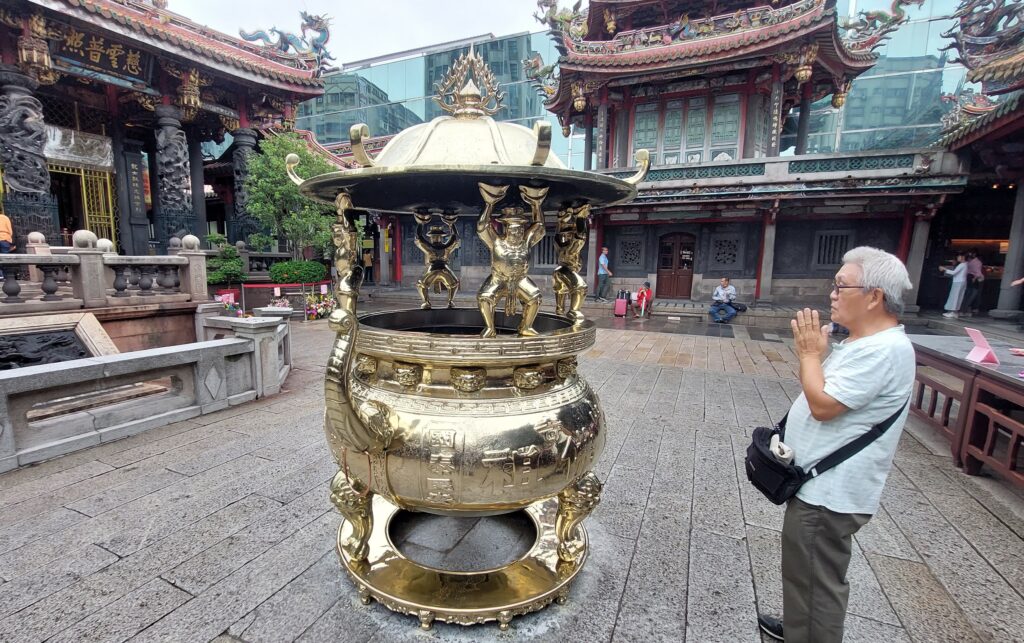

Introduction to Taipei’s Longshan Temple. 台北龍山寺介紹
Longshan Temple in Taipei is the city’s top must-visit temple.
台北龍山寺是台北市第一名必訪的廟宇
In the past, the Han Chinese migrated to and explored Taiwan by sailing across the Taiwan Strait. The waves were strong and the torrents were great at sea. From time to time, shipwrecks occurred. In addition, Taiwan was an unexplored and nasty place with a dangerous environment. In 1709 (during the reign of Emperor Kangxi), Chen, Lai, Zhang Exploration Company, formed by people from three counties in Quanzhou (namely Jinjiang, Nanan and Huian) and Tongan, obtained a permit from the government to explore the island. They began to explore the Taipei Basin systematically.
在過去,漢族人透過航越台灣海峽來移民和探索台灣。海上波濤洶湧,海流湍急,不時發生船隻失事。此外,台灣是一個未被探索、環境惡劣的地方。在1709年(康熙皇帝統治時期),由泉州三縣(晉江、南安和惠安)以及同安的人組成的陳、賴、張探險公司獲得了政府的許可,開始有系統地探索台北盆地。


Later on, people from the three other counties migrated to Taiwan as well. Along with them, they carried the incense pouch from the temple of their hometown to seek the deities’ blessings. Gradually, a settlement was formed in Mengjia. In 1738 (the reign of Emperor Qianlong), they requested the Guanyin Bodhisattva of the Lungshan Temple in Jinan, Fujian to divide her spirit then they carried it to Taiwan. Worshippers raised funds to build the Mengjia Lungshan Temple.
隨後,來自另外三個縣的人也遷往了台灣。他們隨身攜帶著自家寺廟的香袋,以尋求神明的庇佑。漸漸地,在萌嘉地區形成了一個聚居地。在1738年(乾隆皇帝統治時期),他們請求福建晉安龍山寺的觀音菩薩分靈,然後將其帶到台灣。信徒們籌集資金建造了艋舺龍山寺。
The Dragon Gates and the Tiger Gates 龍虎門
The Dragon Gates and the Tiger Gates are our ways to enter and exit the temple. Together with the Front Hall, they form the First Entering, the temple’s main gateway. Now picture yourself as the host of this temple welcoming guests, and you’ll find the Dragon Gates to your left and the Tiger Gates to your right.
龍門和虎門是我們進出寺廟的通道。與前殿一起,它們構成了寺廟的主要入口,稱為「初入」。現在想象自己是這個寺廟的主人,歡迎來賓,你會發現龍門在你的左邊,虎門在你的右邊。
Traditionally, the left side is revered. In Fengshui, there’s the concept of “Dragon to the left; Tiger to the right.” The Taiwanese proverb tells us that to “enter through the dragon, and exit via the tiger” is the way to avoid evil and gain luck. Thus, we have this convention to enter the temple through the Dragon and leave through the Tiger Gates.
傳統上,左側受到尊敬。在風水中,有著「左青龍,右白虎」的概念。台灣的諺語告訴我們,「靠龍進,由虎出」是避免邪惡並獲得幸運的方式。因此,我們有這樣的慣例,通過龍門進入寺廟,通過虎門離開。
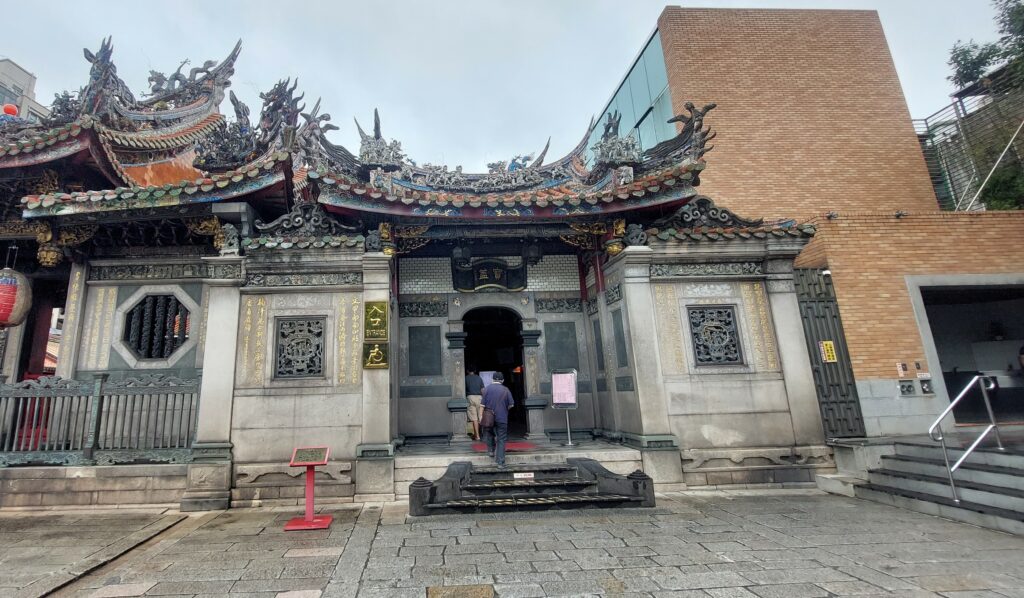

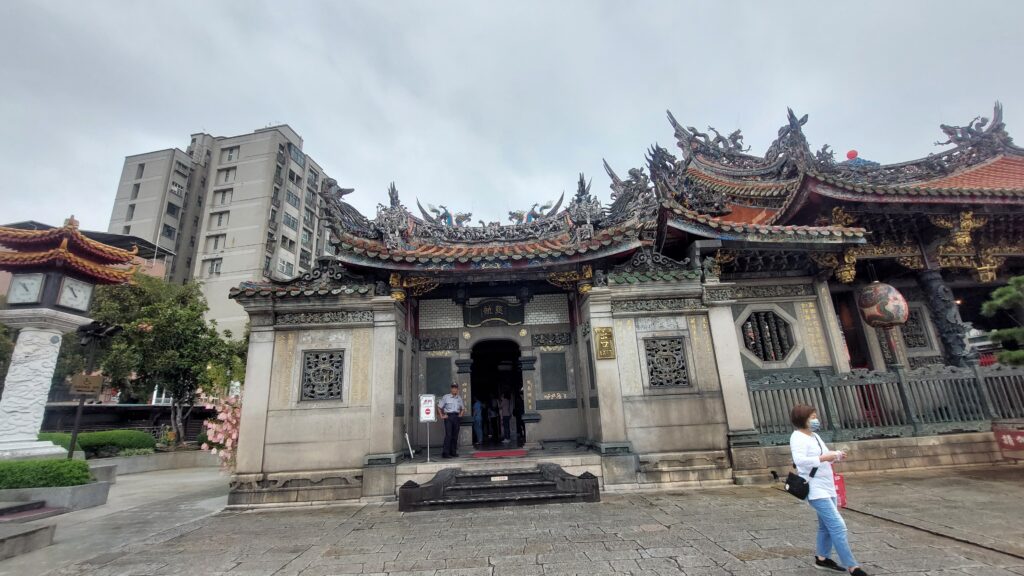

Front Hall 前殿
The Front Hall is where you can see the faithfuls praying and using divination blocks known as “pue” or fortune sticks to ask for Guanyin’s divine guidance.
前殿是你可以看到信徒祈禱並使用稱為「擲筊」或卜筮棒的占卜工具向觀音祈求神聖指引的地方。
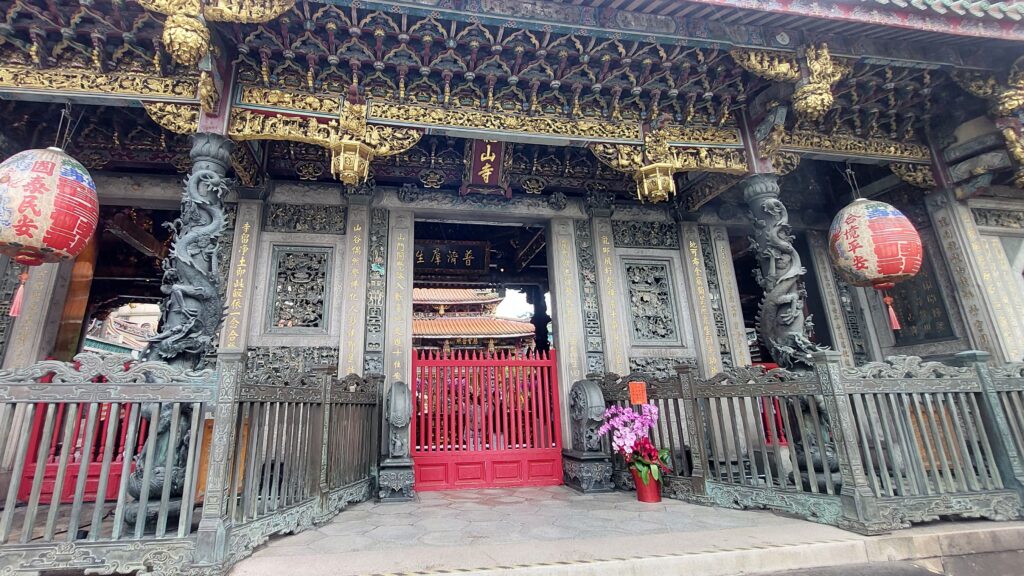

Sanchuan Diann, as the Front Hall is named, is the most intact and oldest building in Lungshan Temple. It is a rare jewel in Taiwan in both architectural and artistic expression. Here you can see the six gates painted with images of Men-shen, the Protecting Door Gods, and an exquisite pair of copper cast dragon columns. Raise your head and you can see the ornate octagonal caisson. There are also many wood carving, stone carving, cochin pottery, and papercrafts to enjoy here.
三川殿,即前殿的名稱,是龍山寺中保存最完整且最古老的建築。它在建筑和艺术表达方面都是台湾的 rare jewel(珍贵之宝)。在這裡,你可以看到六個門上繪有門神的形象,以及一對精美的銅鑄龍柱。仰頭看,還可以看到華麗的八角藻井。這裡還有許多木雕、石雕、琺瑯陶瓷和紙工藝品供您欣賞。
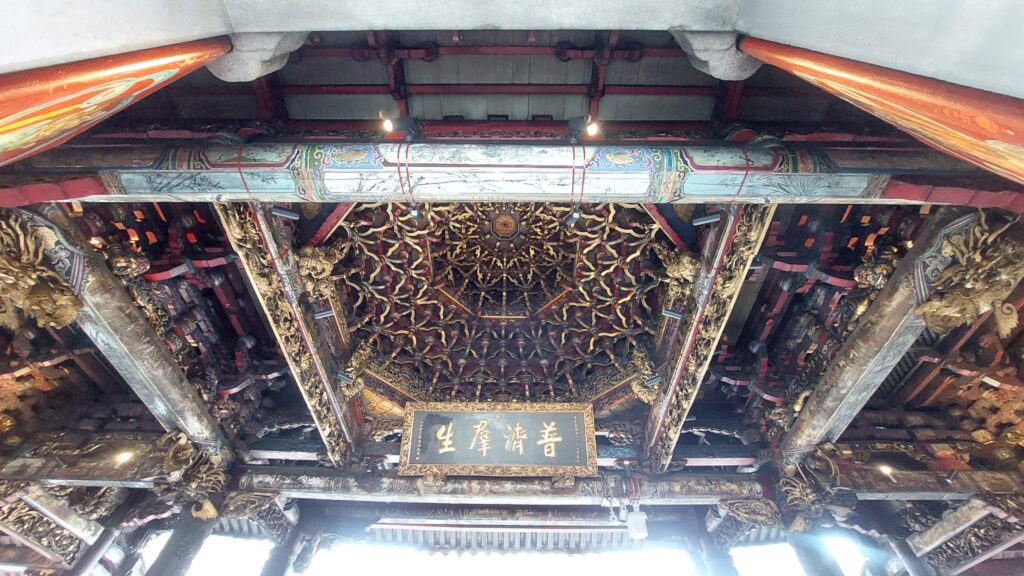

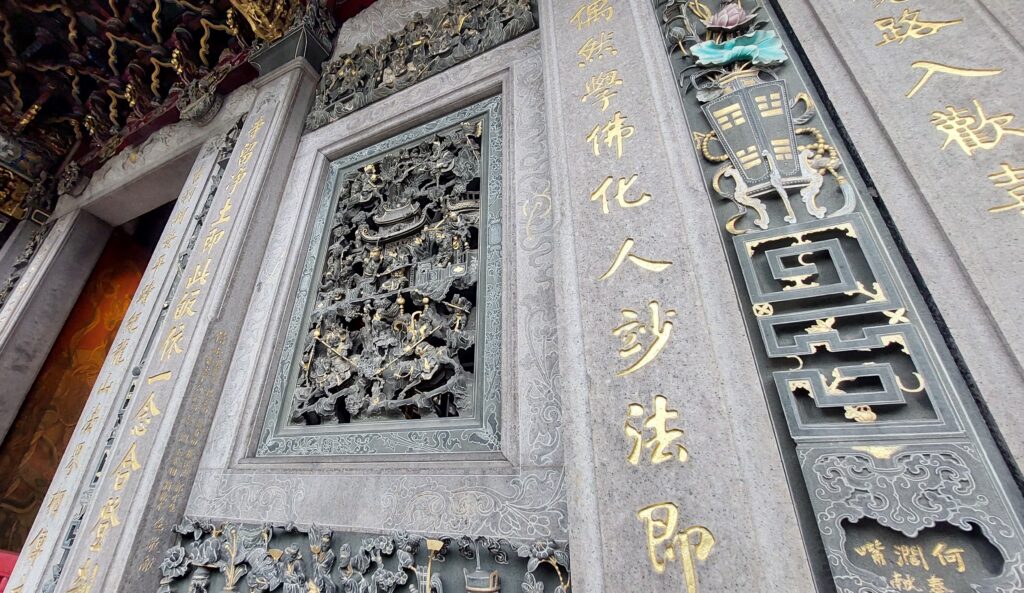

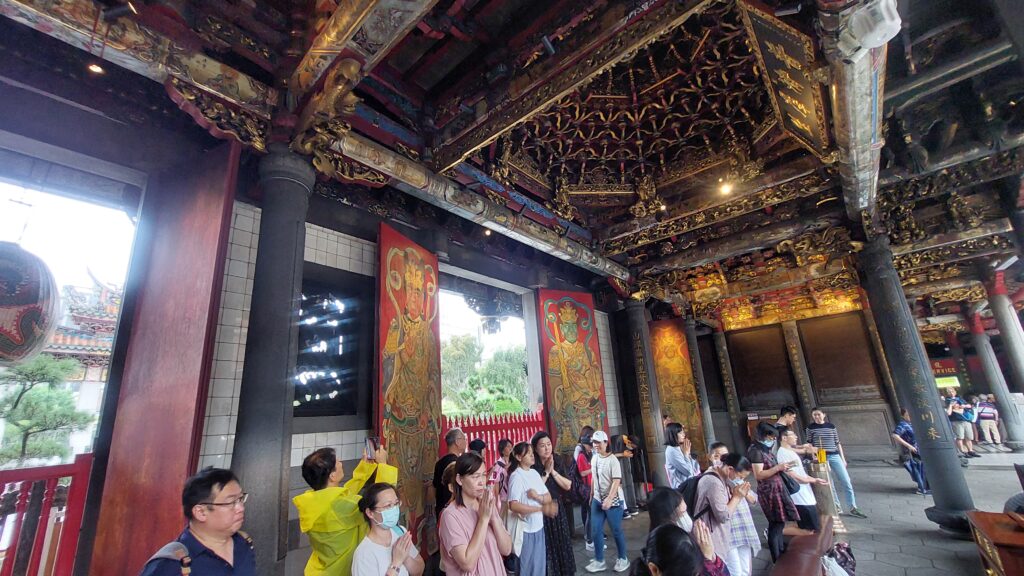

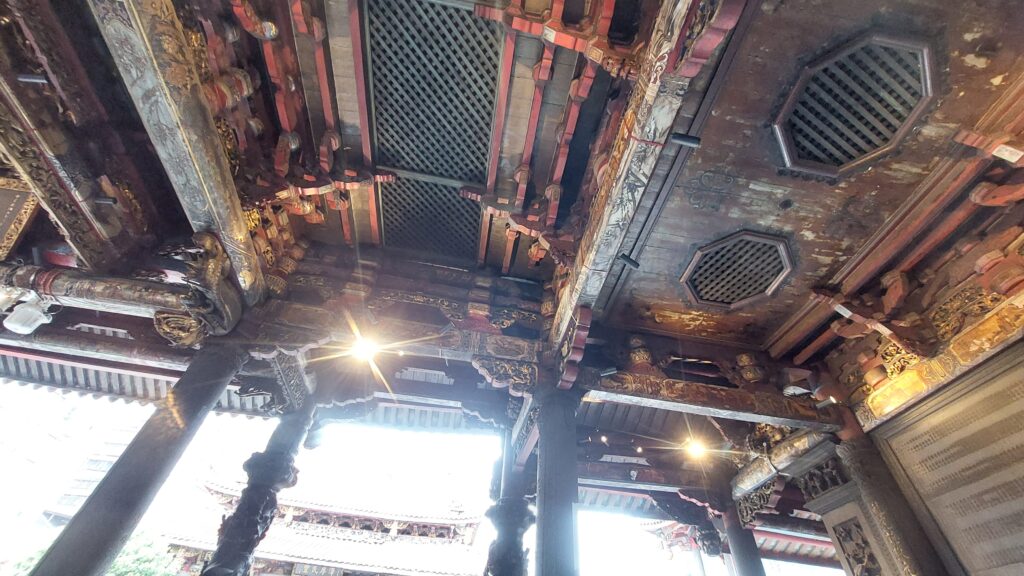

Ask for an chien-shi 求籤問卜
How to ask for an chien-shi (籤詩), oracle poem, with the fortune sticks.
如何求籤
Step 1: Please pay respect to all the deities in the temple before using fortune sticks.
(1) 求籤前請依序將寺內所有神明參拜完,方可求籤。
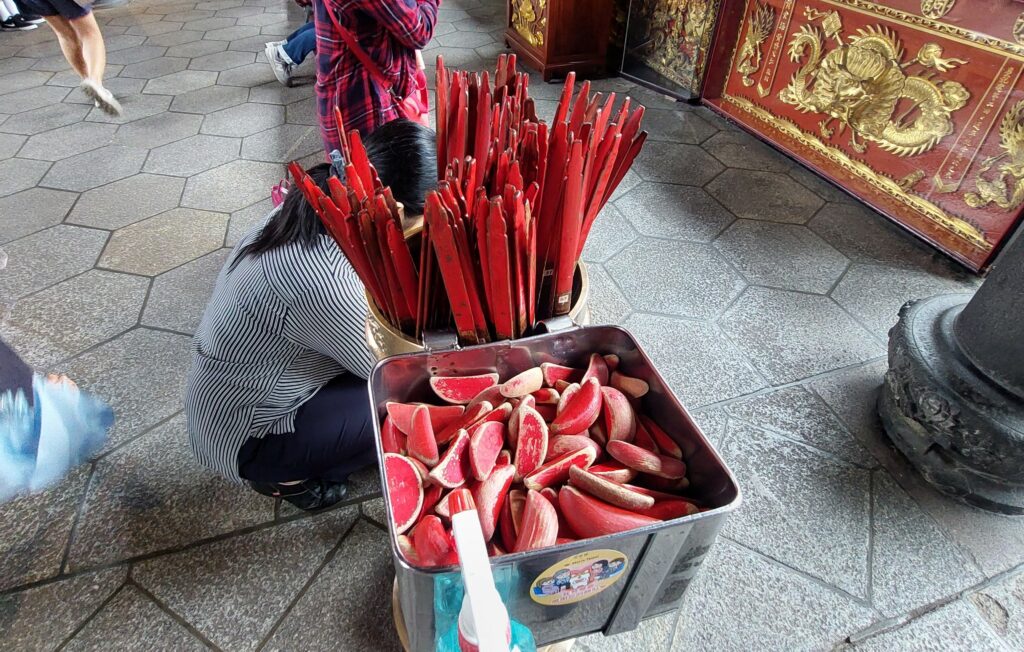

Step 2: Take and hold a pair of poé, divination blocks, from the Front Hall (三川殿) in your hands and face the statue of Guanyin Bodhisattva. State your name, place of residence, and the question you would like to ask. Ask the Bodhisattva “please give me a divine sign if you would grant me an answer today,” then toss the blocks.
(2) 若要求取「觀世音靈籤」,請至三川殿籤筒旁取一對筊,面對著觀音佛祖,雙手捧筊合掌,稟告自已的「姓名」、「生日」、「現居住址」、「遇到的問題」,並詢問佛祖「是否允許賜籤,若允許,請賜一個聖筊」,擲出手上的筊。
Note: Ask only one question per divination poem.
※請注意:一張籤詩只能問一個問題。
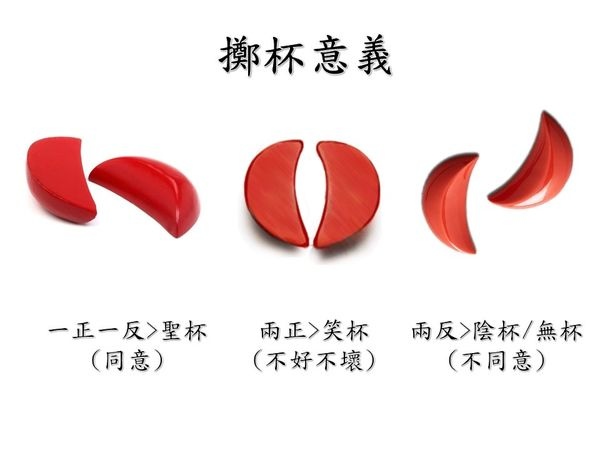

Step 3: Toss the poé blocks.
(3) 擲筊:
A divine sign (聖筊) mean the answer is yes. (Continue to Step 4)
→聖筊:表示佛祖允諾賜籤。(繼續步驟4)
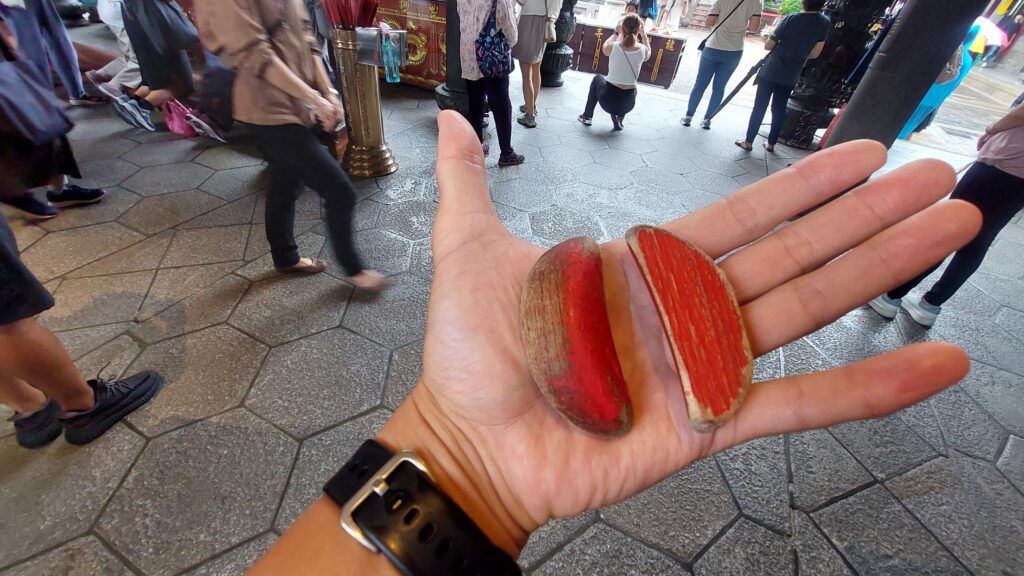

A smile sign (笑筊) signals that the god is still thinking about it. Rephrase your question and then ask again. (Go back to Step 2)
→笑筊:表示神佛一笑,尚未決定是否賜籤,這時請重新向佛祖稟告,稟告完再行擲筊。(回到步驟2)
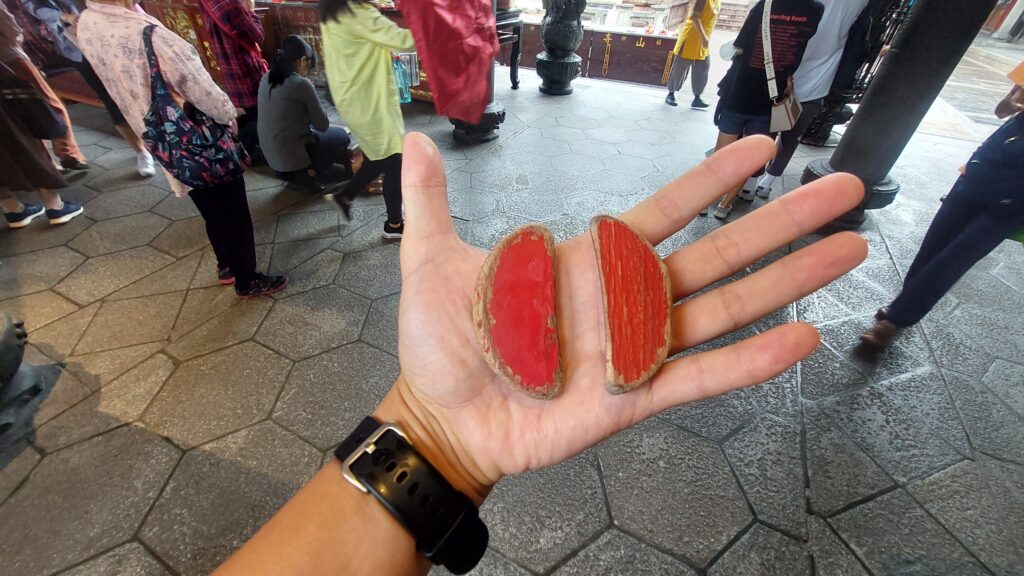

A negative sign (陰筊) means that you would not be given an answer today.
→陰筊:表示佛祖不允求籤。
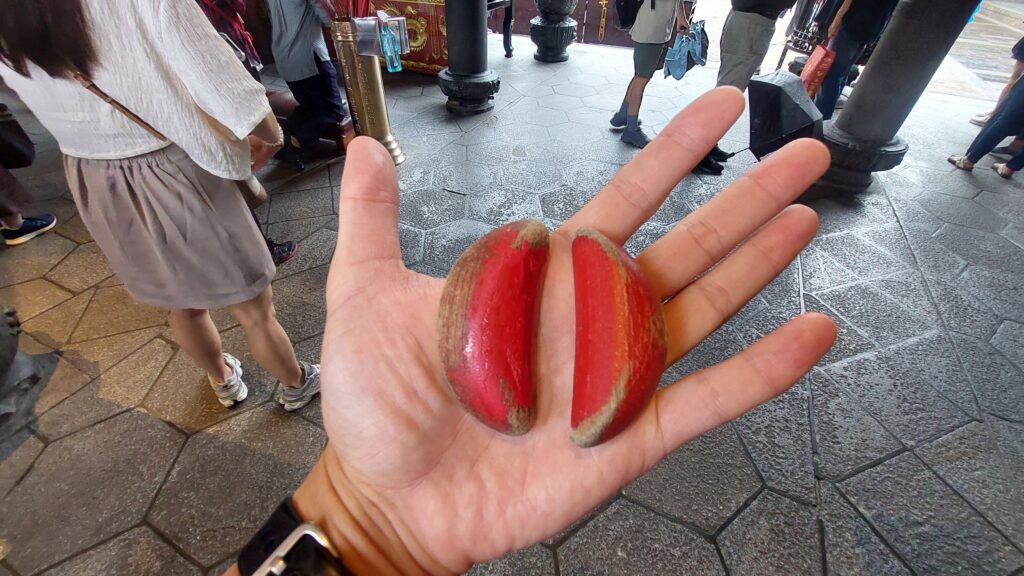

Step 4: Draw a stick from the ‘chien tong’, fortune sticks bucket enough to see the number marked on the stick. Take note of the number then put it back.
(4) 擲出聖筊後,可至籤桶抽一支籤,記下籤號後將籤放回籤筒。
※Do not pull the stick entirely out of the bucket.
※ 請勿將籤枝整個從籤筒內拿出。
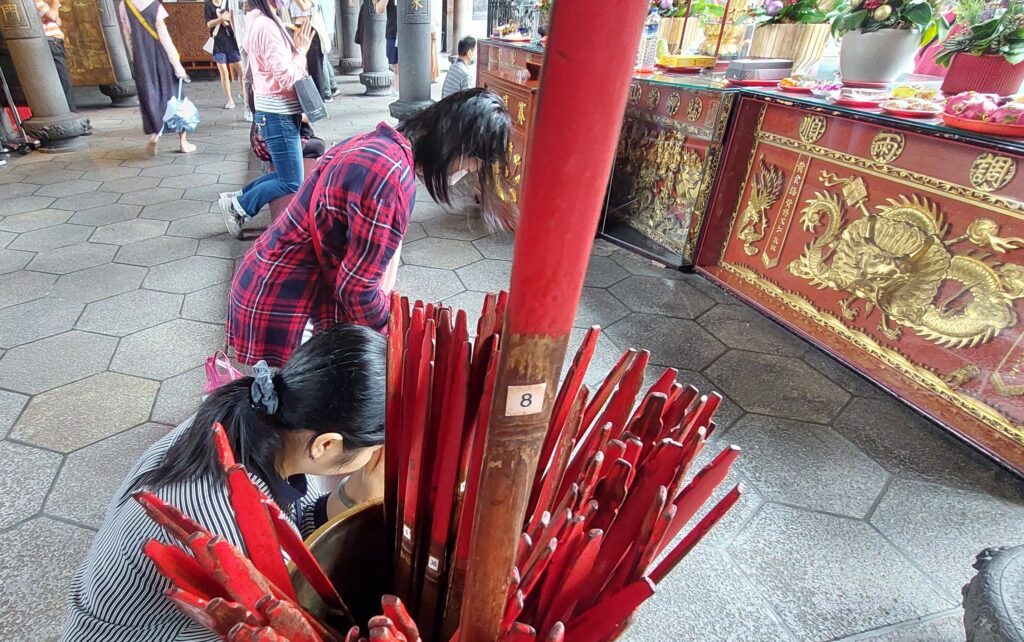

Step 5: Use the poé blocks again to confirm with Bodhisattva if you’ve been granted the answer. The blocks would yield three consecutive divine signs (聖筊) if the answer from the god is affirmative. Otherwise, go back to Step 4 and repeat the process until they do.
(5) 雙手再次捧筊合掌,詢問籤號是否就是佛祖要賜與的,詢問完再擲出手上的筊。如果連續擲出三個聖筊則表示就是這首籤,若擲出任何陰筊或是笑筊則代表不是這首,請回到步驟4重新抽籤,直到出現三個聖筊為止。
Step 6: Go to the poem cabinet and take one poem marked with the same number as the one you’ve drawn from the fortune sticks.
(6) 確認籤號後,前往籤詩櫃依籤號取籤詩,即完成求籤儀式。
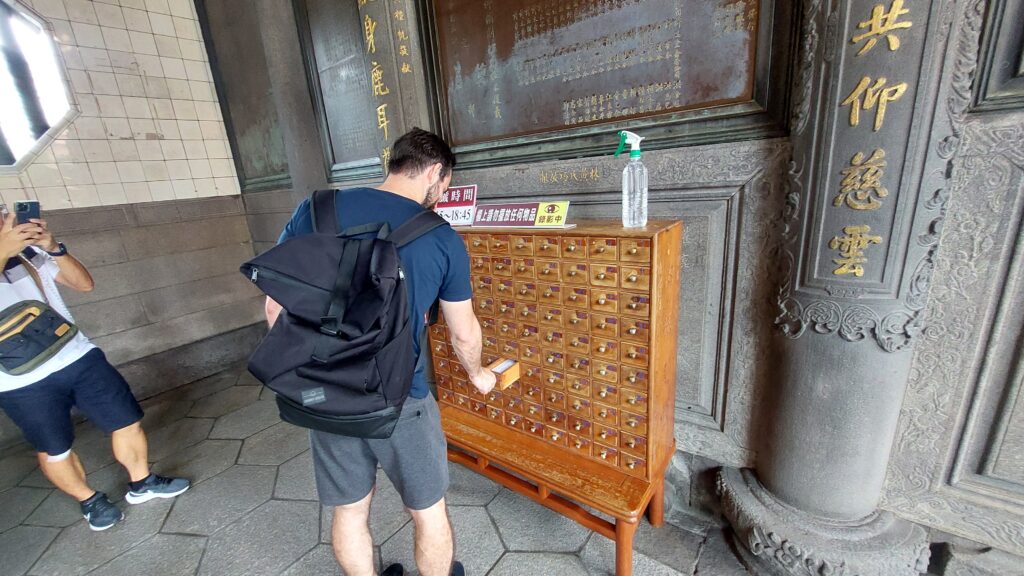

※You can ask one of the poem readers at the temple to explain it for you.
※ 三川殿的籤詩櫃上,放有《觀世音靈籤註解》可以查詢,若依舊無法瞭解籤文,可至解籤處詢問解籤人員。
Center Hall 主殿
Follow the steps on either sides and you have now reached Jon-diann, the Center Hall, officially stepping into the Second Entering. On the main shrine sits Longshan Temple’s main deity Guanyin Bodhisattva on the Lotus Throne. She is the most well-known goddess to the Taiwanese people; like a mother, her warmth guides and protects us all. The saying “a Guanyin in every household” is a testament to her popularity and influence for the people.
沿著左右兩側的階梯,您現在已經來到了中殿,正式進入了寺廟的「二入」。在主壇上坐著龍山寺的主神觀音菩薩,坐在蓮花寶座上。她是台灣人民最熟悉的女神,就像一位母親,她的溫暖指引並保護著我們所有人。諺語「家家戶戶有觀音」證明了她的受歡迎程度和對人們的影響。
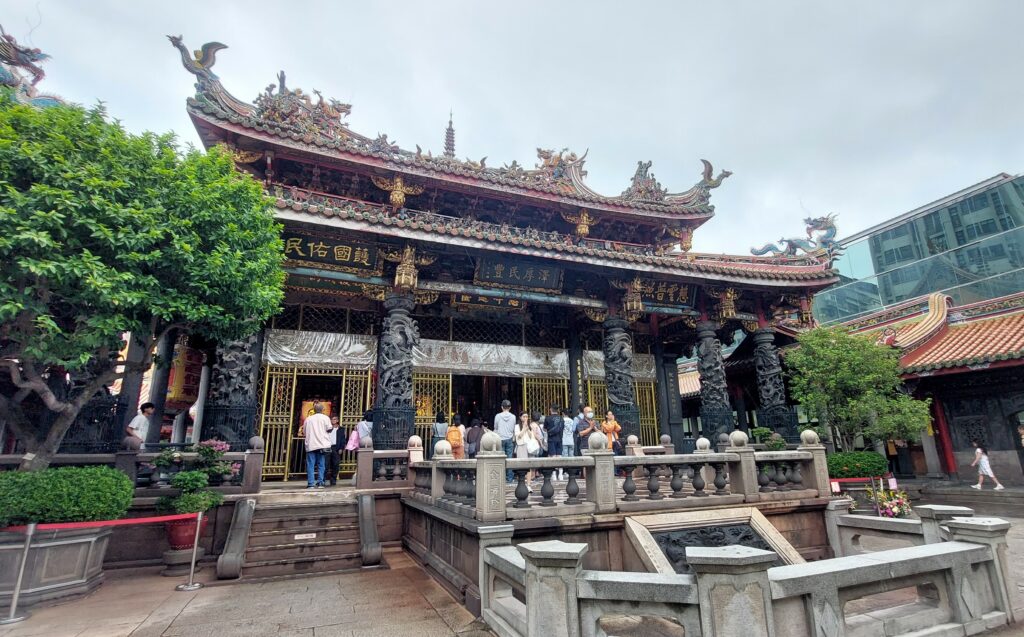

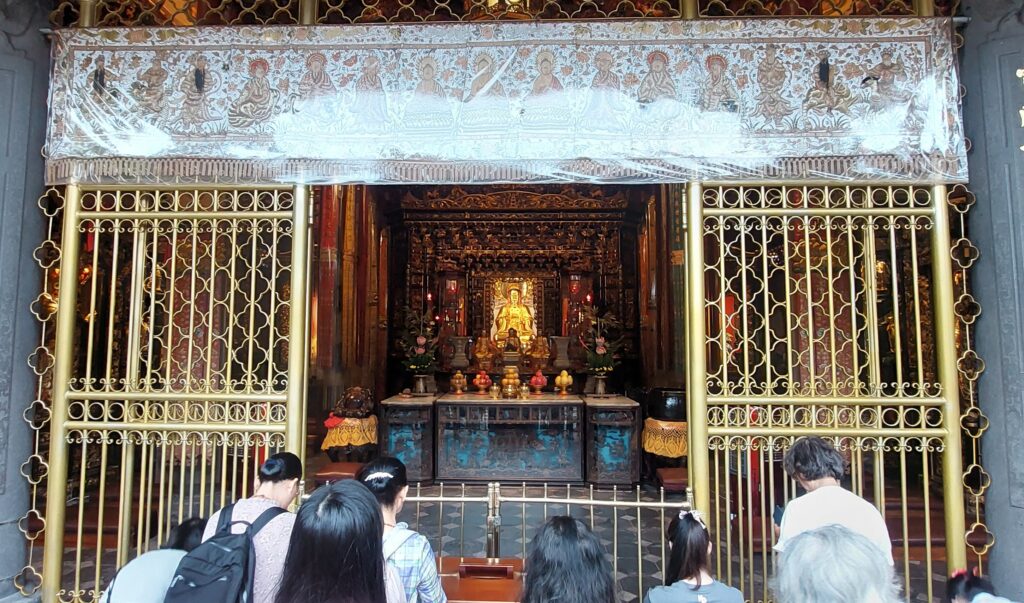

To the left and right, we can see statues of Wen-shu Bodhisattva and Pu-sian Bodhisattva with the guardians Wei-tuo and Jia-lan.
在左右兩側,我們可以看到文殊菩薩和普賢菩薩的雕像,以及護法神韋馱和迦蘭。
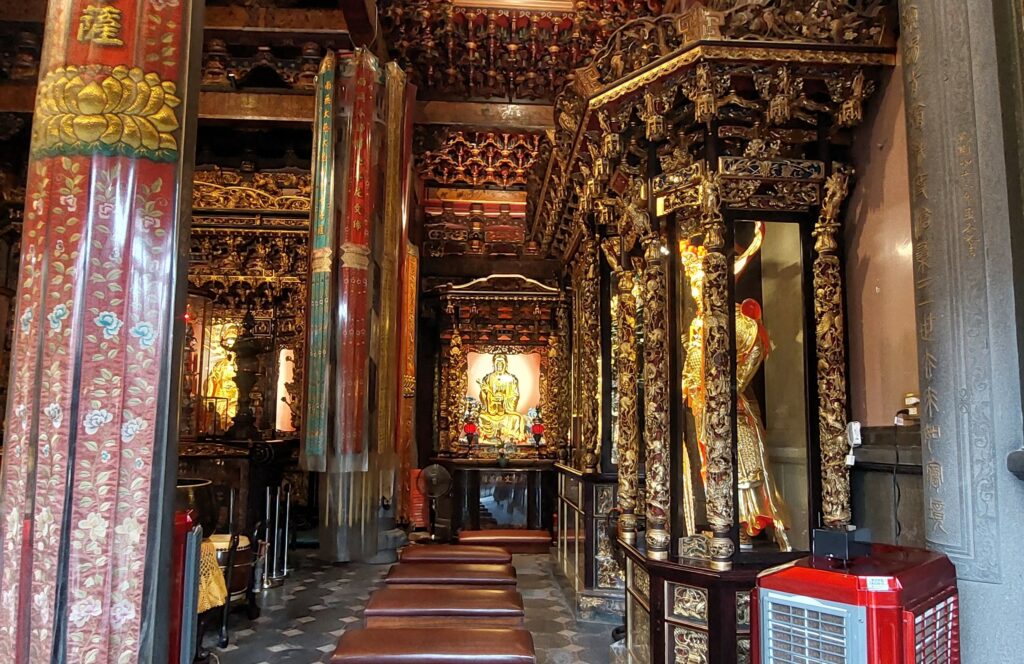

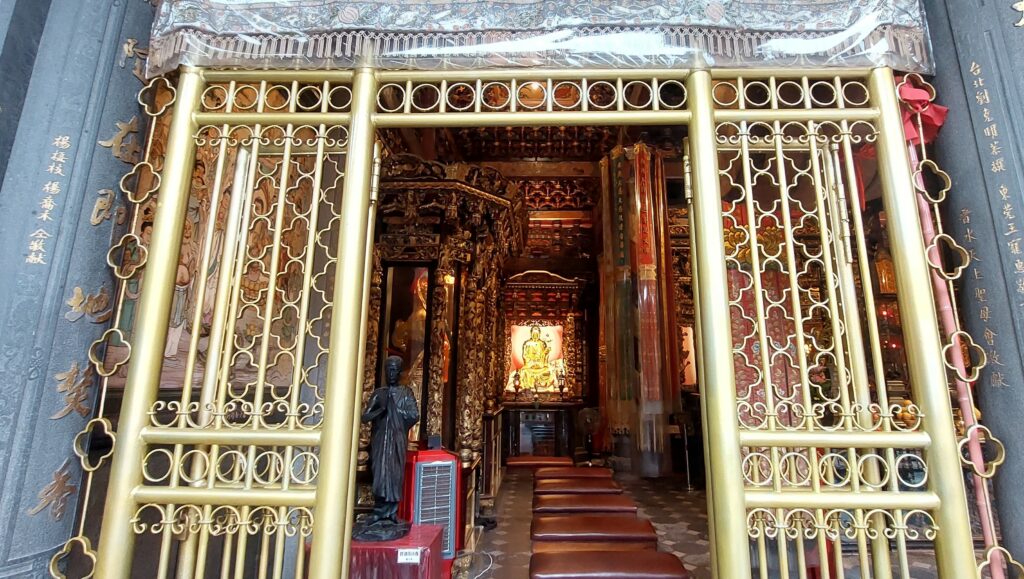

The walls are dedicated to the 18 Arahants, or the insightful ones, as well as Shan-shen, the God of the Mountains, Tudishen, the God of Soil and Earth, and also Sihai-longwang, Dragon King of the Four Seas. This is where you can see the polytheistic character of Taiwan folk religion.
牆上供奉著18羅漢,或稱為有智慧的人,以及山神、土地神和四海龍王之神祇。這是您可以看到台灣民間信仰多神教性格的地方。
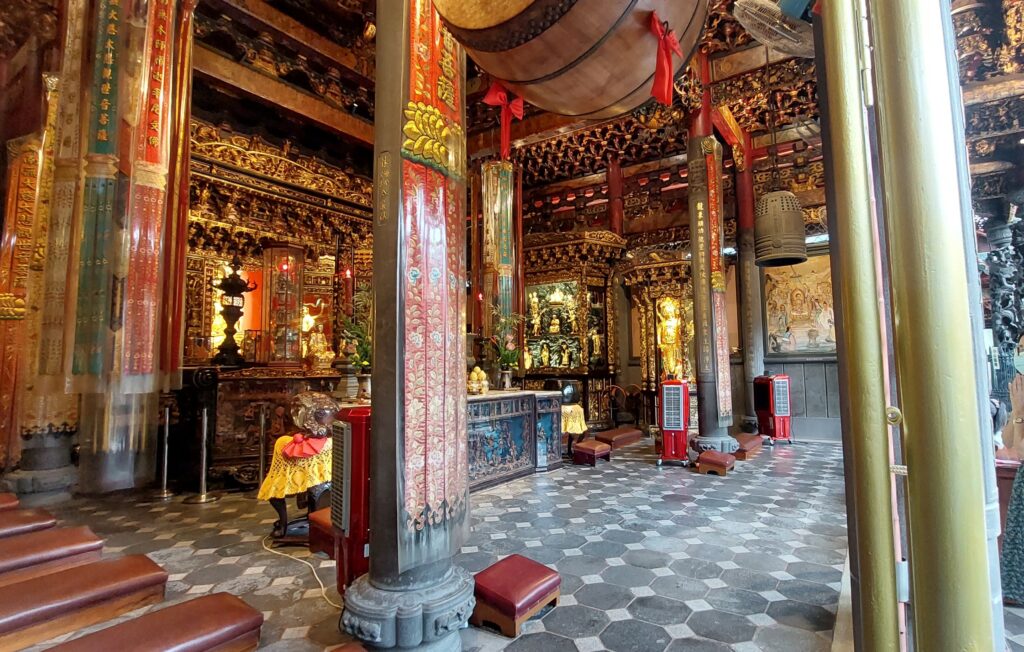

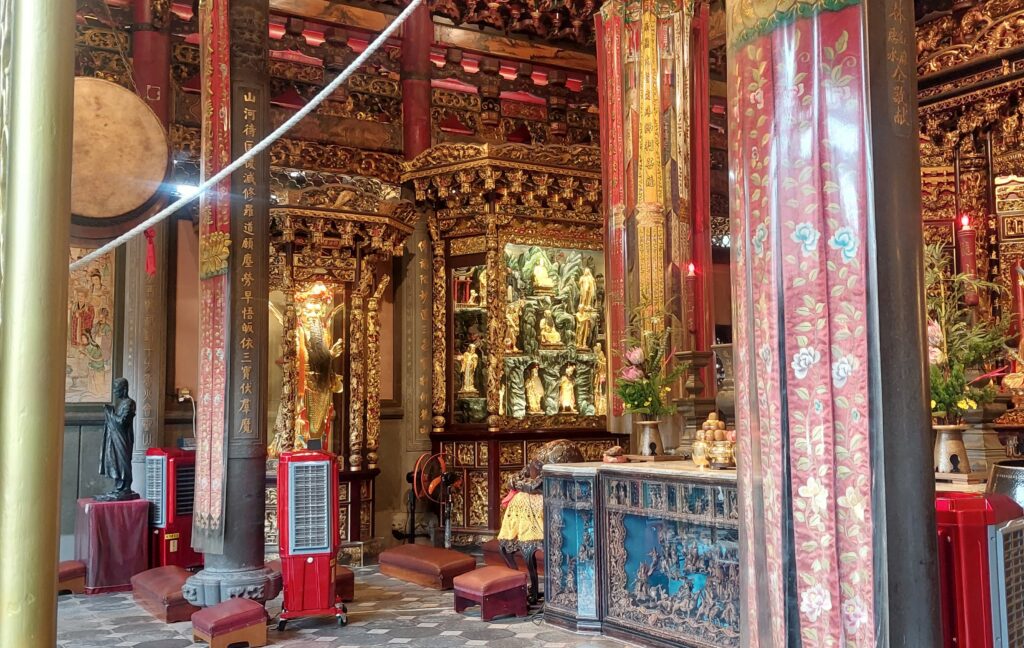

During WWII, the main hall was totally destroyed by bombs. However, the statue of Guanyin still remained, sitting solemnly on the lotus seat. The worshippers believe that miracle is “A Incarnation of Guanyin Bodhisattva.”
在第二次世界大戰期間,主殿遭到炸彈完全摧毀。然而,觀音菩薩的雕像仍然肅穆地坐在蓮花座上。信徒相信這一奇蹟是「觀音菩薩的化身」。
Rear Hall 後殿
We are finally at the Rear Hall. Taiwan is a society that embraces diversity in religions as well as their variety of deities. It is not uncommon to see multiple gods worshiped in one temple, as is the case of Manka Longshan Temple. From cradle to grave, we experience different life stages, each carrying their own brand of anxiety or yearning. The Rear Hall is where people come for guidance and answers。
我們終於來到了後殿。台灣是一個擁抱宗教多元性以及各種神祇的社會。在一座寺廟中崇拜多位神祇並不罕見,就像是龍山寺的情況一樣。從搖籃到墳墓,我們經歷不同的生命階段,每個階段都帶有自己特有的焦慮或渴望。後殿是人們尋求指導和答案的地方。
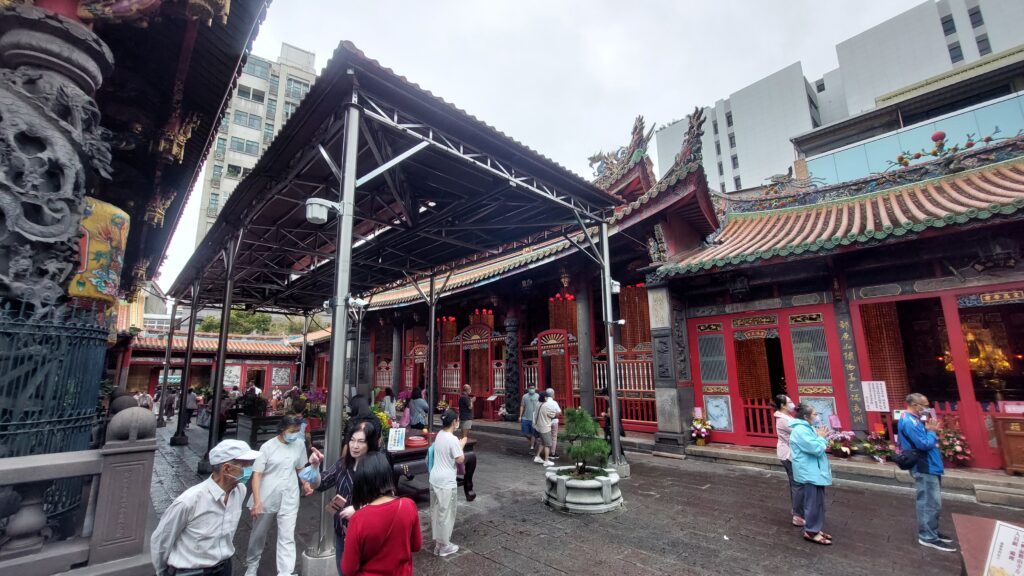

In addition to Mazu the Heavenly Lady, whose shrine sits in the center, we can also see the shrine dedicated to Ju-sheng Niang-niang, the Goddess of Fertility, and her company of the Twelve Helpers. They are worshiped by those that wish to enter or are expecting parenthood. Also in the same Hall is Wenchang Dijun, who is worshiped by those who wish to excel academically or professionally.
除了媽祖坐鎮中央的神壇外,我們還可以看到供奉著生育之神妈祖及她的十二位侍奉神祇的神壇。這些神祇受到那些希望進入或正在期待育兒的人們的崇拜。同樣在同一大殿中還有文昌帝君,他受到那些希望在學業或職業上有所突出的人們的崇拜。
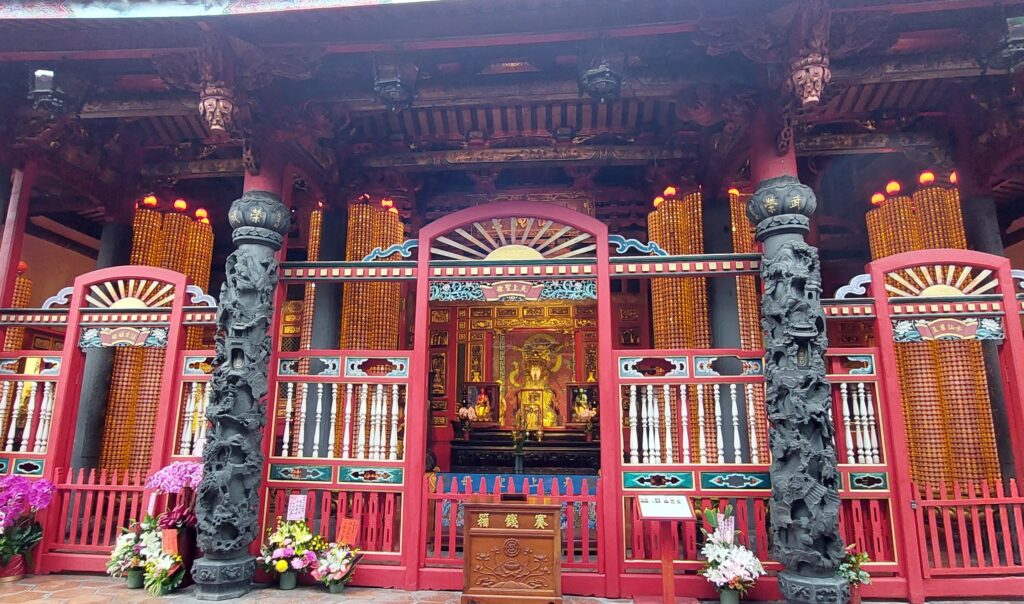

To Hua-tuo, the God of Medicine, people pray for health. Business people come to Longshan Temple to pay respects to Guān Shèng Dì Jūn, the god of business and finance. The Hall of the Devine Matchmaker Yue Lao is the most popular place in Longshan Temple. Every day, local and international visitors by the hundreds come to ask for the Red Thread and his blessings on their love life or marriage.
至於華佗,醫神,人們則祈禱健康。商人前來龍山寺尊敬財神關聖帝君。月老,姻緣之神,位於月老神壇,是龍山寺中最受歡迎的地方。每天,數百名本地和國際遊客前來請求紅線和他對他們的愛情生活或婚姻的祝福。
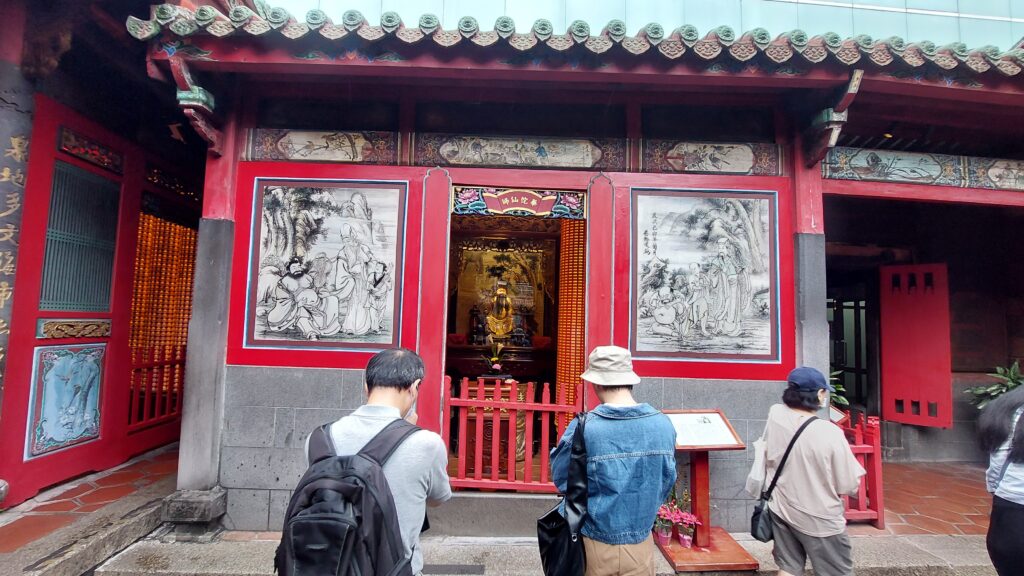

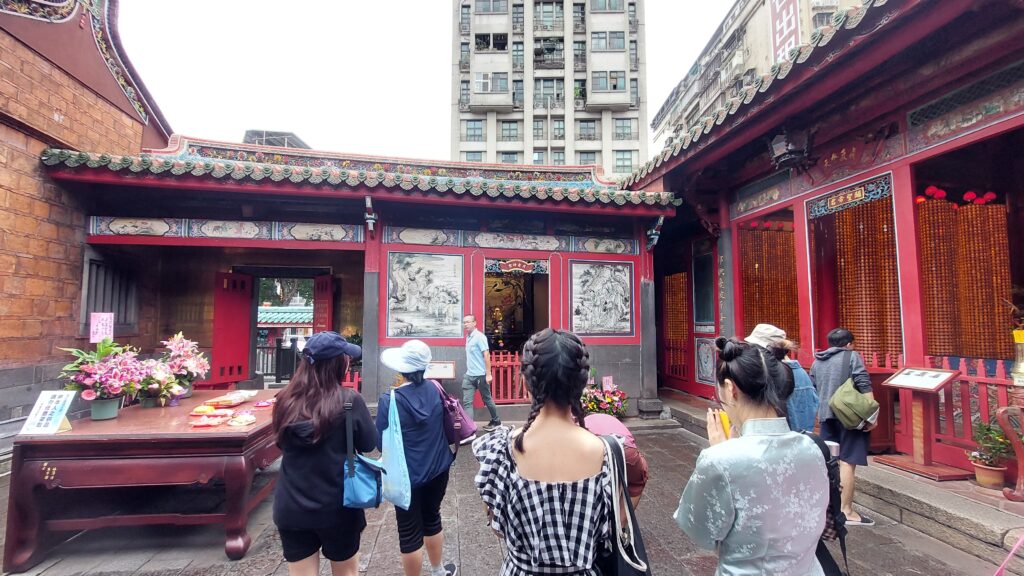

Lungshan Temple has developed unique rituals to suit the varied wants of its patrons. Something you can tell from what’s presented on the offerings tables in the Rear Hall.
龍山寺已經發展出獨特的儀式,以迎合不同願望的朝聖者。這一點可以從後殿的供桌上呈現的東西看出來。
For example, those asking for academic or professional success might bring the following items for Wenchang Dijun because the sounds of their names liken those of auspicious phrases: spring onion, for its Chinese pronunciation Tsong is similar to that of the word for brilliance; radish or Tsai-tou for good fortune; and sticky rice dumplings, Zong-ze for being accepted for an academic or professional position.
例如,那些希望在學業或職業上取得成功的人,可能會為文昌帝君帶來以下物品,因為它們的名稱發音類似吉祥的詞語:蔥代表聰明(其中文發音”蔥”類似於”聰”);蘿蔔代表好運(其中文發音”蔡頭”類似於”財頭”,意為財富);糯米粽代表被錄取(其中文發音”糯擇”類似於”被擇”,意為被選中)。
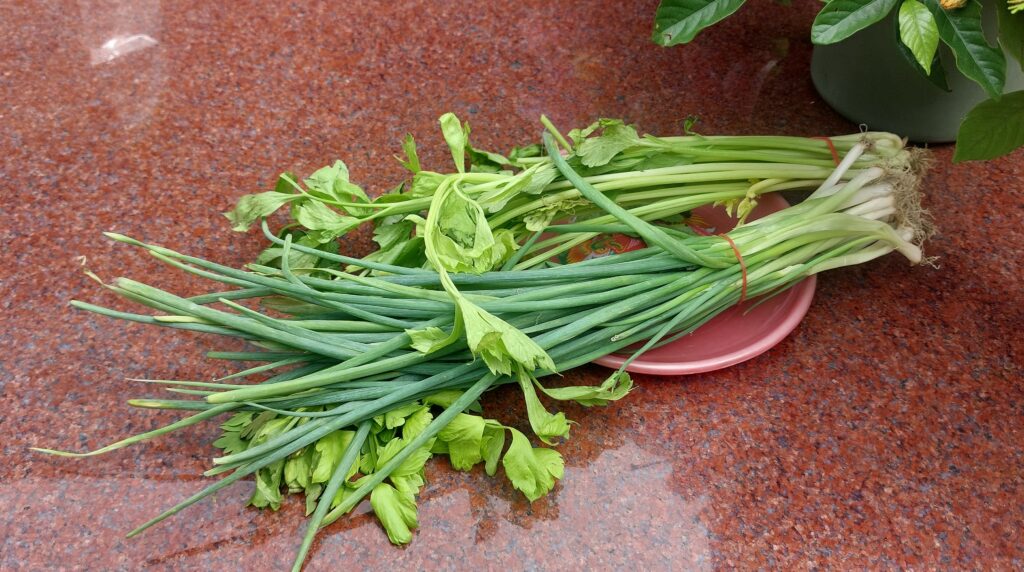

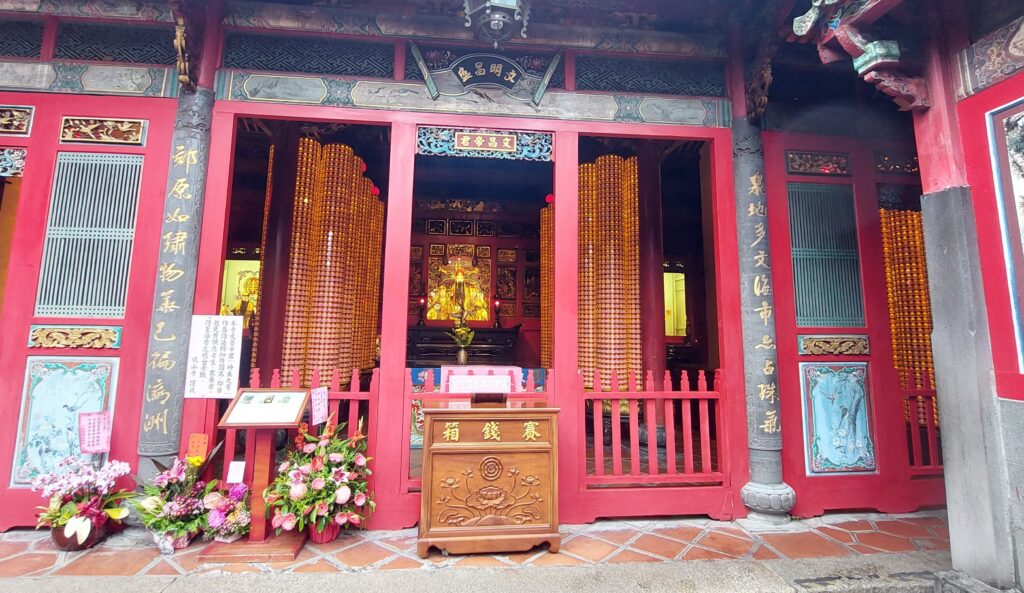

Worshipers of the Goddess of Fertility will offer the symbolic flowers or fruits–for their bearing many seeds. And can you guess which offerings on the table are for Yue Lao the Matchmaker, who is well-known for having a sweet tooth?
崇拜生育之神妈祖的信徒會獻上象徵多子多孫的花朵或水果。至於月老紅娘,以喜好甜食而聞名,你能猜出供桌上哪些供品是為他而準備的嗎?
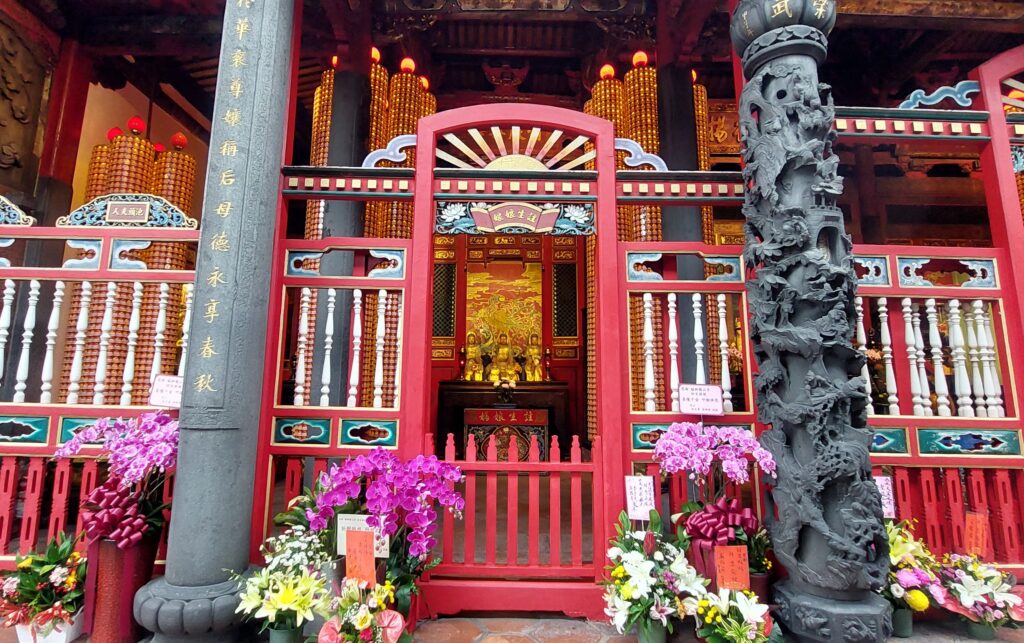

Here in the Rear Hall of Manka Lungshan Temple, you can visit and pray to the gods and goddesses while getting a glimpse of the unique religious customs and cultures of Taiwan.
在龍山寺的後殿,您可以參拜神祇,同時一窺台灣獨特的宗教習俗和文化。
Klook.com龍山寺掛燈籠的用意? The purpose of hanging lanterns in temples
Lanterns, aside from being ancient lighting tools, also symbolize good fortune in traditional Chinese Feng Shui and fortune-telling. This is because the word for “lantern” sounds similar to the word for “offspring,” signifying prosperity in the family. During the Lunar New Year, households hang red lanterns to create a festive atmosphere, making lanterns a symbol of celebration for Chinese people.
燈籠不僅是古代用以照明的工具,在傳統風水命理學中,它也是一種吉祥的象徵,又因「燈」與「丁」讀音相近,更意味著人丁興旺,被人們視爲吉祥好預兆。每年的農曆正月,家家戶戶都要掛起象徵吉祥的紅燈籠,來營造一種喜慶的氛圍,燈籠也成爲中國人喜慶的象徵。
In a long-ago legend, when fierce birds and beasts were rampant, causing harm to people and livestock, the villagers organized themselves to fight them off. A divine bird had lost its way and landed in the human world, only to be accidentally shot by an unknowing hunter. The Heavenly Emperor, upon learning of this, became extremely angry and issued a decree, ordering celestial soldiers to set fire to the human world on the fifteenth day of the first lunar month, burning everything in their path.
傳說在很久以前,凶禽猛獸很多,四處傷害人和牲畜,人們就組織起來去打它們,有一隻神鳥因為迷路而降落人間,卻被不知情的獵人給射死了。天帝知道後十分震怒,傳旨下令,讓天兵於正月十五到人間放火,把人間的人畜財產通通燒光。
The Heavenly Emperor’s daughter, filled with compassion, couldn’t bear to see innocent people suffer and secretly came to the human world to inform the people. A clever individual came up with a solution, suggesting that everyone decorate their homes with lanterns and fireworks on the fifteenth, sixteenth, and seventeenth days of the lunar month. This would make the Heavenly Emperor believe that his orders had already been carried out. On the fifteenth night, the Heavenly Emperor looked down and saw a sea of red lights and heard thunderous sounds for three consecutive nights, thinking it was the result of a massive fire. To commemorate this successful event, from then on, every fifteenth day of the lunar month, households hang lanterns to celebrate this day.
天帝的女兒心地善良,不忍心看百姓無辜受難,就偷偷來到人間,把這個消息告訴了人們。一個聰明人想出個法子,他讓大家在正月十五、十六、十七這3天都在家裡張燈結彩、點響爆竹、燃放煙火,這樣一來,天帝就會以為天兵已經放過火了。到了正月十五這天晚上,天帝往下一看,發覺人間一片紅光,響聲震天,連續3個夜晚都是如此,以為是大火燃燒的火焰而作罷。為了紀念這次成功,從此每到正月十五,家家戶
戶都掛燈籠,來紀念這個日子。
Temple lanterns bear auspicious phrases like “National Prosperity and People’s Well-being” and “Favorable Winds and Abundant Rains.”
寺廟掛的燈籠 吉祥話 國泰民安 風調雨順 根據此內容 用最生活化的字彙精簡翻成英文
剪粘 Cut and paste.
“剪黏” is a noun that combines the actions of “cut” and “paste.” “Cut” refers to shaping ceramic or glass pieces into the desired form, and “paste” means attaching these processed materials onto an existing clay or plaster surface. Due to factors such as cost-effectiveness and long-lasting preservation compared to Vietnamese ceramics, as well as the relative simplicity of production, “剪黏” gained widespread acceptance after being introduced to Taiwan.
剪黏是由「剪」與「黏」兩個動作組成的名詞,「剪」指的是裁剪陶瓷片、玻璃片成為需要的樣子,「黏」則是指將這些處理過的材料黏在已有雛形的泥灰表面上。由於剪黏相比交趾陶便宜,且保存期限久,製作相對簡便等因素,傳入臺灣後廣為接受。
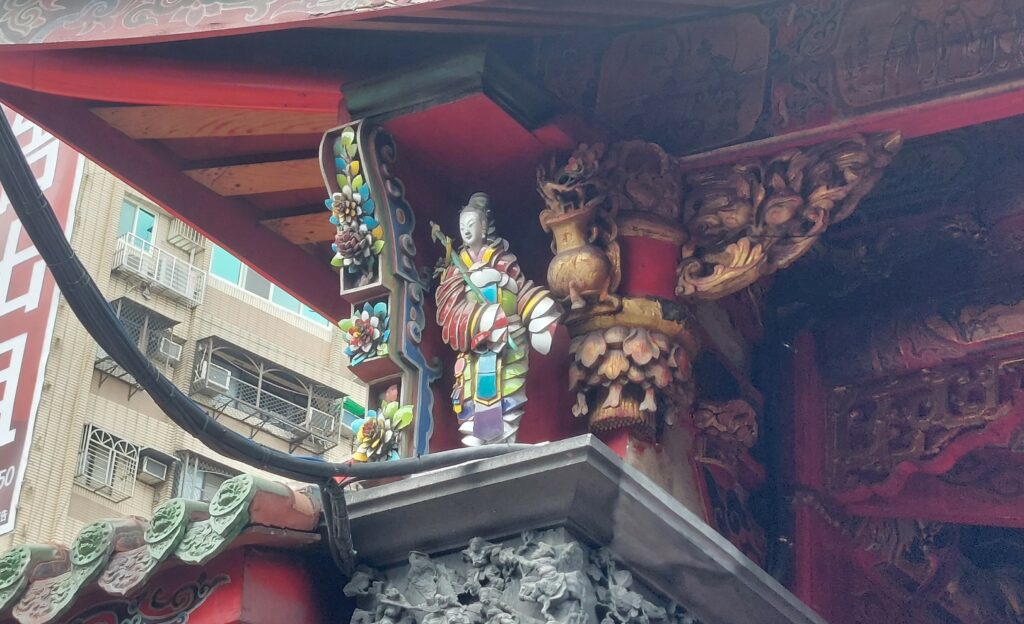

為何供桌要拜鮮花水果? Why are fresh flowers and fruits offered on the altar?
Flowers represent the cause. The saying goes, “flowers bloom and bear fruit,” where flowers are the cause of bearing fruit. Without the process of flowers blooming, it signifies a lack of fruitful harvest. Offering flowers on the altar is a reminder for sentient beings to sow the cause of becoming a Buddha, which will lead to the fruition of Buddhahood in the future. What is the cause of becoming a Buddha? All acts of altruism and self-purification are causes of becoming a Buddha. With the reminder of the representative cause, “flowers,” we are encouraged to regularly confess and reflect on our words and actions, continually striving toward our great aspiration of Buddhahood.
花是代表因。所謂「花開結子」,花是結子的因,沒有花開的過程,也表示沒有結果的收穫。供桌前供花是提醒眾生要多播種成佛的因,將來才會有成佛的果。什麼是成佛的因呢?一切利他的善行,一切自淨的提升都是成佛的因。有了代表因的「花」的提醒,我們才會經常披露懺悔,反省自己的言行,向著成佛的大願不斷精進。
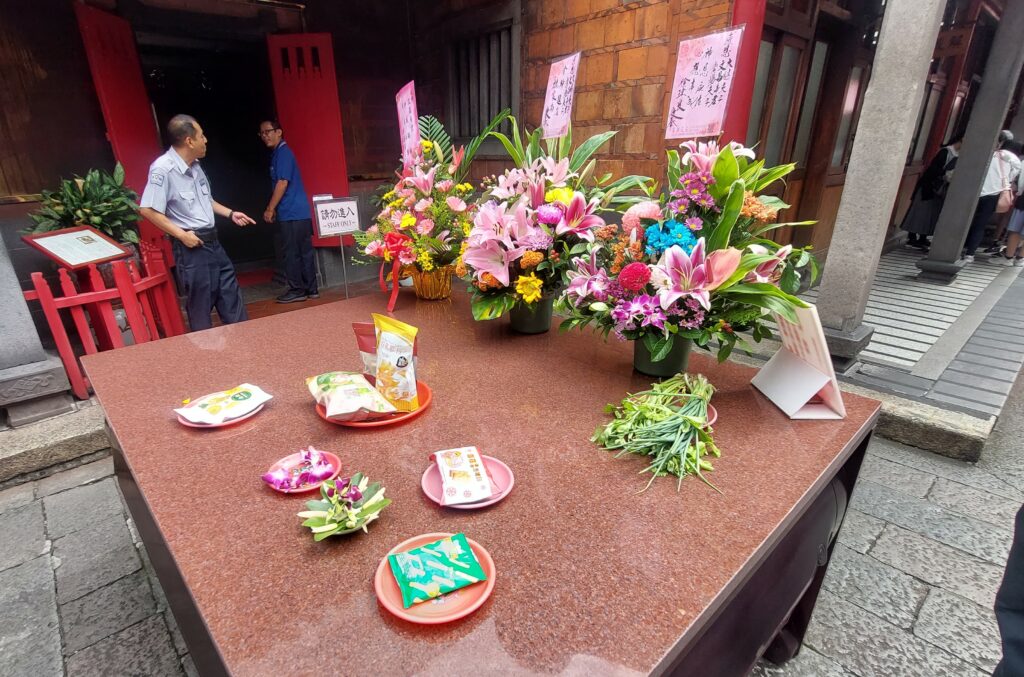

(Fruits) Fruits represent the results.
Buddhism places the greatest emphasis on the law of cause and effect. Everything in the world is interconnected with the principle of cause and effect, as in the saying, “All things are empty, but the law of cause and effect is not.” “Plant good causes, reap good results; plant bad causes, reap bad results.”
From the smallest word to the tiniest action or thought, there is always a cause and an effect. So, when we see fresh fruits, it serves as a reminder to be mindful in our words and actions at all times and in all things. We should avoid harboring unwholesome thoughts and desires because if we wish for good results, we must surely nurture good causes and intentions in our thoughts and intentions.
(水果)果是代表結果。 佛教最重視因果法則的,萬事萬法不離因果,所謂「萬法皆空,因果不空」、「種善因,得善果;種惡因,得惡果」。 細微至一言一行一念,都有因有果。所以看到鮮果,便提醒自己時時、事事都要謹言慎行,不可起心動念,希望有善果,就必定在起心動念間含藏善因善意。
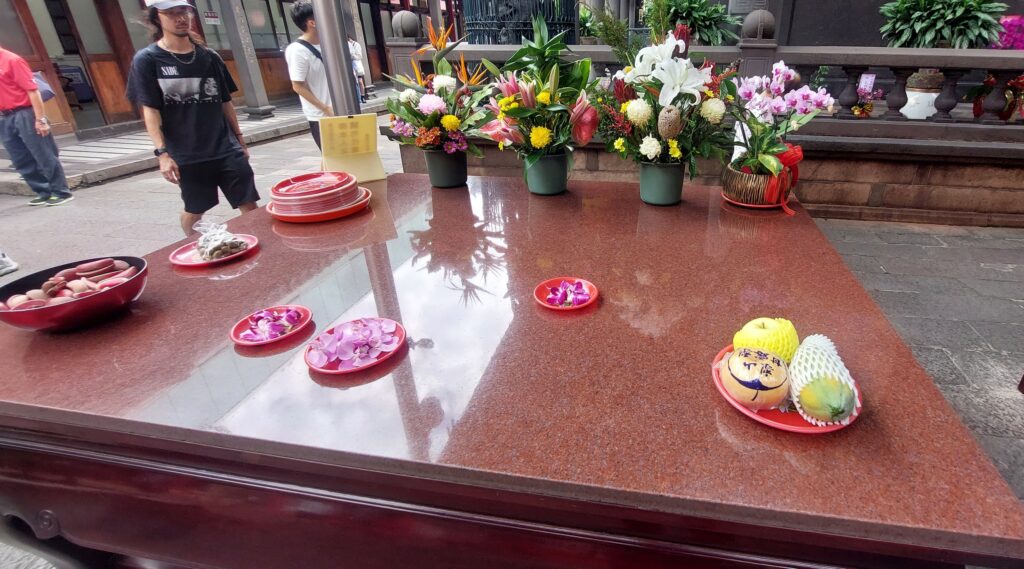

光明燈 Light Offering
“光明燈” and “平安燈” are lamps lit as offerings to deities and Buddhas. According to scripture, offering sincere prayers with the light of a lamp brings immeasurable blessings. These blessings have the power to bring increasing brightness and peace to one’s life, which is why they are called “光明燈” or “平安燈.” Additionally, because the lamps offered to deities and Buddhas are never extinguished, they are also known as “長明燈,” “常明燈,” or “無盡燈,” which translates to “eternal lamps” or “endless lamps.”
光明燈」、「平安燈」,都是燃燈供神佛的意義,據經典中記載,致誠心以燈明來供神佛是有無量福報,因為這個福報,作用是能使人生越來越光明、平安,所以稱為「光明燈」或「平安燈」,又因為供神佛的燈是不滅,所以也稱為「長明燈」、「常明燈」或「無盡燈」等。
In Buddhist and Taoist temples, you often find “光明燈,” small-sized and numerous, designed for use by worshippers, with efforts to extend their burning time. The fees for these lamps also serve as a significant source of temple revenue. In Europe and the Americas, in Catholic churches, there are similar small votive candle stands, where believers can light candles, symbolizing their faith in Christ’s light shining upon others in the world.
佛教、道教的寺廟中,經常都設有光明燈,近日光明燈,體積小、數量多,設計來給信徒使用,並盡可能延長其燃燒時間,而光明燈的收費,也是許多廟宇重要的香火錢來源。在歐美,天主教教堂中,也有類似光明燈的小蠟燭座,讓教徒點燃,代表自己對基督的信仰能照耀世上其他人。
In a temple, every year during the Chinese New Year, people light “光明燈” once. If someone wants to light these lamps in multiple temples, that’s also possible. The purpose of lighting “光明燈” is to pray for blessings for the living, so it cannot be done for deceased parents or infants. The lamps are inscribed with the person’s name, date of birth, and address, and blessings are offered through recitation of scriptures.
在一間廟堂,每年新春時點光明燈,一年點一次。如果想要到很多廟堂都點光明燈,也是可以的,點光明燈的意義是為活人祈福,所以不能為死去的父母或嬰靈點光明燈。光明燈上會記上當事人的姓名、出生年月日、住址,誦經祈福。
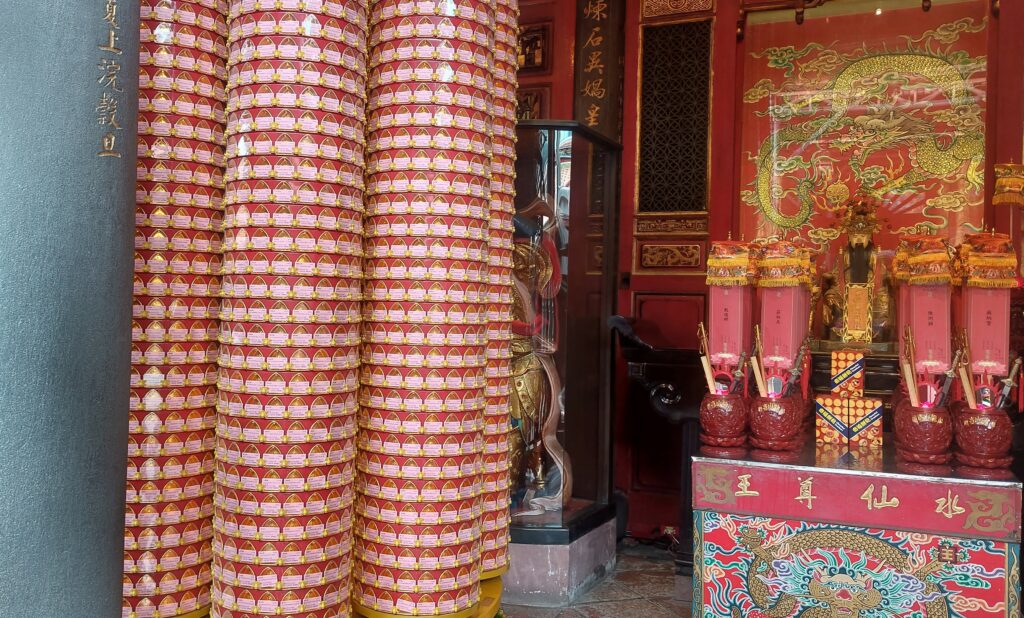

龍山寺的賽錢箱 The donation box at Longshan Temple.
It used to be called “adding oil,” and it was indeed adding oil. In temples, instead of lighting candles, they used butter lamps. To seek safety, they would add butter to these lamps to manifest light.
以前叫做添香油,是真正的添香油,廟裡的燈不是點蠟燭,而是點酥油的酥油燈,為了求平安,都會添點酥油進去,以顯光明。
Nowadays, candles are lit, or electric bulbs are used, so it has shifted to cash donations. People inside the temple can buy them themselves, which is why it’s called “香油錢” (oil money). To prevent negligence, they’ve placed a box for worshippers to contribute on their own. Some boxes are labeled “香油箱” (oil money box), and some people believe that adding oil for the lamps is a meritorious act, so it has been changed to “功德箱” (merit box).
現在都點蠟燭了,或者用電燈泡,所以就改換成現金,讓廟裡面的人自己去買,所以叫做香油錢。為避免人的疏忽,所以乾脆放個箱子讓信徒自己投進去,有的是寫『香油箱』,那有人就認為添油香是做功德,就改成『功德箱』。
As for the “賽錢箱,” it’s meant to give donating worshippers a competitive element, to see who can contribute more. That’s why it’s labeled as the “賽錢箱,” with the meaning that the more, the better.
至於『賽錢箱』,那是為了要讓捐獻的信徒有點比賽的意味,看誰捐得多,所以就寫成『賽錢箱』,多多益善的意思。
The “賽錢箱” is typically found in larger main temples, while smaller shrines mostly use “功德箱” (merit box).
賽錢箱應該大宮廟才會出現,小廟壇大都用功德箱。
結論
Every time I visit Taipei’s Longshan Temple, I always feel a sense of peaceful and positive energy. It’s very serene and comforting. So, the temple’s atmosphere is really wonderful for people. I hope everyone can also visit temples more often, connect with the positive energy, and bring more foreign friends to Longshan Temple in Taipei to experience this positive energy together.
每一次來到台北龍山寺總是會覺到一股祥和的正能量,感覺很平靜,很舒服,所以廟宇的磁場是對人很棒的,希望大家也能多往寺廟走走,多接觸善的能量,一起帶更多的外國朋友來台北龍山寺,感受這股正能量吧。
I’m Mike. When you come to Taiwan, remember to contact me, and I’ll take you to visit Longshan Temple in Taipei.
我是麥克,來台灣記得找我帶你去台北龍山寺玩喔。
延伸閱讀~旅行安全大作戰!出門前10個實用旅遊安全小tips
旅市假期~尋找適合您的跟團行程
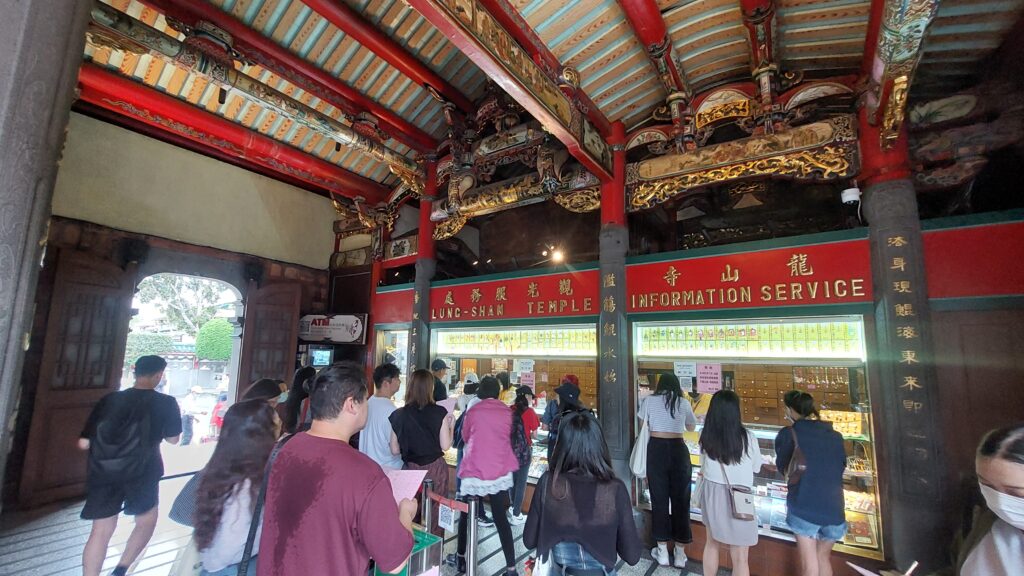

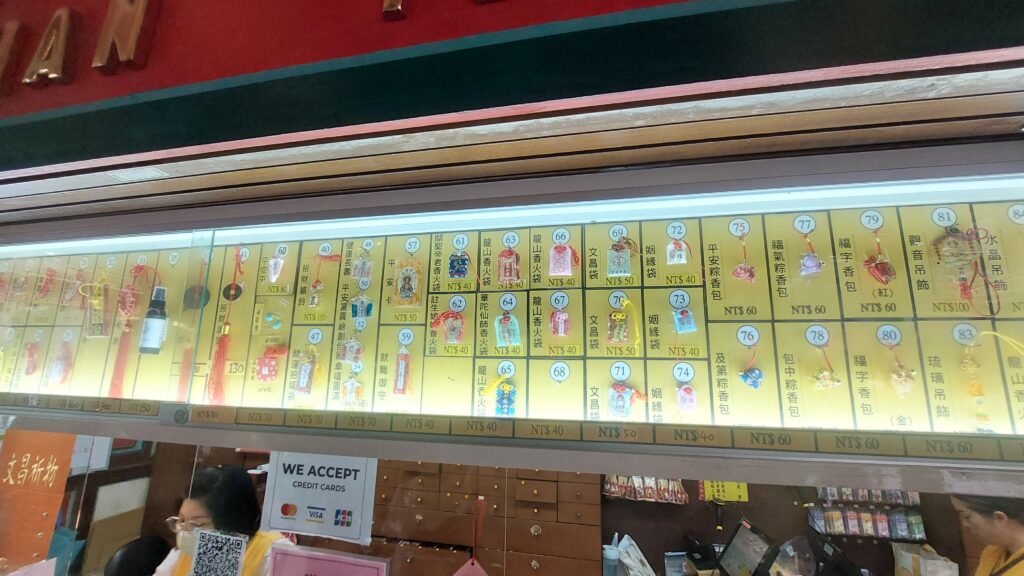

✴歡迎加入麥克GO! FB粉絲專頁👇

